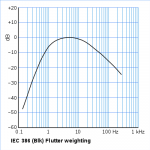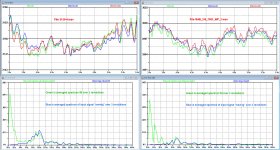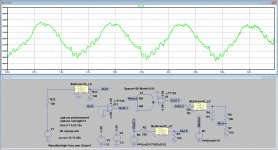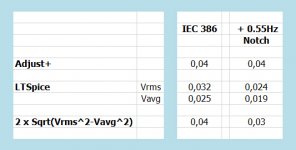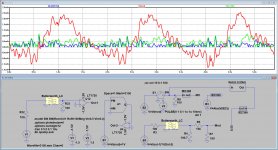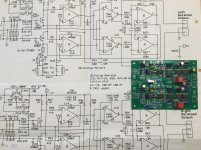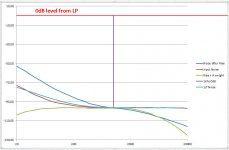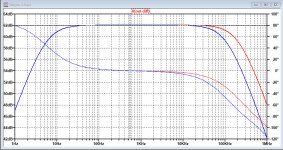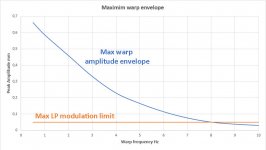Dimitri,
I had to dive deep into my archives and found that I spent quite some time after all in this area.
Here is the background of the matter.
All LF Cart resonance frequencies lead to IM modulation of the higher frequencies because of the movement of the needle, moving its position forward and backwards.
AES has defined an IEC 386 Flutter filter, see curve below.
This is their explanation:
3.2 Wow
Frequency modulation of the signal in the range of approximately 0,5 Hz to 6 Hz resulting in distortion which
may be perceived as a fluctuation of pitch of a tone or program.
3.3 Flutter
Frequency modulation of the signal in the range of approximately 6 Hz to 100 Hz resulting in distortion which
may be perceived as a roughening of the sound quality of a tone or program.
Up to 6Hz, a fluctuation of pitch is perceived, where our auditory system is most sensitive somewhere around 4Hz. Especially piano music is very critical.
Above 6Hz, IM may sound to be perceived as rough, but above 13Hz it starts to interfere with the music content, that's why 13Hz may be seen as Fres max.
But at the same time as already mentioned, Fres below 10Hz tends to increase the IM products, probably because of higher amplitude.
That's why generally 10 to 13Hz is regarded to be an optimum.
This IM can never be avoided by any filter, no matter whether before or after the Riaa EQ and has a pure mechanical cause.
The second image shows 3 revolutions of two different TT recordings both playing a 3150Hz tone.
The upper part shows the FM demodulated signal, also showing the eccentricity of the LP, and the lower part in green the spectrum of the FM demodulated signal, still without the IEC 386 filtering, which would completely remove 0.55Hz part from eccentricity for which our ears are insensitive.
In blue you see the spectrum of the non demodulated vertical Cart movement, being Left channel minus Right channel, showing a very strong correlation between IM products and the vertical "waving"
The third image shows the model I used for demodulating the 3150Hz signal.
The fourth image shows the spectrum when FM modulating a 1Khz signal with a 10Hz, like the recording I've shown a few postings before this one.
Hans
.
I had to dive deep into my archives and found that I spent quite some time after all in this area.
Here is the background of the matter.
All LF Cart resonance frequencies lead to IM modulation of the higher frequencies because of the movement of the needle, moving its position forward and backwards.
AES has defined an IEC 386 Flutter filter, see curve below.
This is their explanation:
3.2 Wow
Frequency modulation of the signal in the range of approximately 0,5 Hz to 6 Hz resulting in distortion which
may be perceived as a fluctuation of pitch of a tone or program.
3.3 Flutter
Frequency modulation of the signal in the range of approximately 6 Hz to 100 Hz resulting in distortion which
may be perceived as a roughening of the sound quality of a tone or program.
Up to 6Hz, a fluctuation of pitch is perceived, where our auditory system is most sensitive somewhere around 4Hz. Especially piano music is very critical.
Above 6Hz, IM may sound to be perceived as rough, but above 13Hz it starts to interfere with the music content, that's why 13Hz may be seen as Fres max.
But at the same time as already mentioned, Fres below 10Hz tends to increase the IM products, probably because of higher amplitude.
That's why generally 10 to 13Hz is regarded to be an optimum.
This IM can never be avoided by any filter, no matter whether before or after the Riaa EQ and has a pure mechanical cause.
The second image shows 3 revolutions of two different TT recordings both playing a 3150Hz tone.
The upper part shows the FM demodulated signal, also showing the eccentricity of the LP, and the lower part in green the spectrum of the FM demodulated signal, still without the IEC 386 filtering, which would completely remove 0.55Hz part from eccentricity for which our ears are insensitive.
In blue you see the spectrum of the non demodulated vertical Cart movement, being Left channel minus Right channel, showing a very strong correlation between IM products and the vertical "waving"
The third image shows the model I used for demodulating the 3150Hz signal.
The fourth image shows the spectrum when FM modulating a 1Khz signal with a 10Hz, like the recording I've shown a few postings before this one.
Hans
.
Attachments
Last edited:
Whilst you can't get rid of the IM I'm still biased towards an elliptic filter for treatment of what we can get rid of. Note this is elliptic as in the Neumann mastering filter, not a classic EE elliptical filter. Basically you mix the signal to mono below around 100Hz as the cutting was done that way so no vertical motion is encoded on the vinyl.
Makes me wonder what I could do differently with my rotated Ortofon which has lateral and vertical coils...
Makes me wonder what I could do differently with my rotated Ortofon which has lateral and vertical coils...
In my opinion that is absolutely wrong.
If you ask me I would say that the rumble filter should be placed as soon as possible in the chain.
I don’t agree.
Level of the rumble is way below the loudest possible LF music signals.
No reason at all to fear any overload.
Hans
Adjust+ is the perfect way to measure Fres, adjust your cart optimally, but also to measure the IM products we have been discussing with a 3150Hz test tone.
This is what they promise:
Wow and flutter:
The software records the values and analyses the spectrum of deviations over 30 seconds. You finally get values on wow and flutter in %.
You will find values for the maximum deviation as well as the symmetrical evaluation according to DIN IEC 386 (formerly DIN 45507) using the methods '2-Sigma' and 'dynamic' (Pro version only).
All the values are evaluated twice: the first time using the unfiltered raw measured speed values and the second time using a steep 0.55Hz notch filter to eliminate an eventual eccentricity of the test record.
I used my LTSpice model to see in how far both gave similar results.
Measurement of IEC 386 should be done by calculating the 2σ value of the absolute value of the demodulated and IEC 386 filtered signal.
This is calculated as 2*sqrt(Vrms^2+Vavg^2).
A value of 0.1% from the original 3150Hz level is seen as the threshold of our auditory system and 0.04% is a very good value for systems with a well tuned arm/cart.
See first Image for results expressed in %.
In the second image, showing the demodulated, the IEC 386 and the additional notch filtered signals, 1mV corresponds to 0.1%.
This image only shows 3 revolutions for better visibility, but for accurate results a time window of 30 sec should be used.
The eccentricity in the demodulated signal looks almost as if a prehistoric TT was used, but this method is so revealing, that it calculates to an off-centre of the LP hole of only ca.0.19mm !
Hans
.
This is what they promise:
Wow and flutter:
The software records the values and analyses the spectrum of deviations over 30 seconds. You finally get values on wow and flutter in %.
You will find values for the maximum deviation as well as the symmetrical evaluation according to DIN IEC 386 (formerly DIN 45507) using the methods '2-Sigma' and 'dynamic' (Pro version only).
All the values are evaluated twice: the first time using the unfiltered raw measured speed values and the second time using a steep 0.55Hz notch filter to eliminate an eventual eccentricity of the test record.
I used my LTSpice model to see in how far both gave similar results.
Measurement of IEC 386 should be done by calculating the 2σ value of the absolute value of the demodulated and IEC 386 filtered signal.
This is calculated as 2*sqrt(Vrms^2+Vavg^2).
A value of 0.1% from the original 3150Hz level is seen as the threshold of our auditory system and 0.04% is a very good value for systems with a well tuned arm/cart.
See first Image for results expressed in %.
In the second image, showing the demodulated, the IEC 386 and the additional notch filtered signals, 1mV corresponds to 0.1%.
This image only shows 3 revolutions for better visibility, but for accurate results a time window of 30 sec should be used.
The eccentricity in the demodulated signal looks almost as if a prehistoric TT was used, but this method is so revealing, that it calculates to an off-centre of the LP hole of only ca.0.19mm !
Hans
.
Attachments
But at the same time as already mentioned, Fres below 10Hz tends to increase the IM products, probably because of higher amplitude.
That's why generally 10 to 13Hz is regarded to be an optimum.
This IM can never be avoided by any filter, no matter whether before or after the Riaa EQ and has a pure mechanical cause.
.
Dual implemented a mechanical damping of the tonearm resonance in their Dual CS 721 model. The tonearm had an „anti-resonator“ built into the counterweight. The manual says that “the inner part weight is matched to the tomearm resonance und thus acts as anti-resonator by means of antiphase vibration.”
Not sure what other negative side effects the wobbly counterweight had, but at least the resonance should have been tamed.
Level of the rumble is way below the loudest possible LF music signals.
No reason at all to fear any overload.
Hans
Hans, yes, any quality record player will have negligible rumble.
However, one must also consider warped records. Happ and Karlov from Shure reported that on small sample of randomly selected records warp amplitudes greater than 0.002 cm were not uncommon even at 10Hz, and much, much greater at lower frequencies. These amplitudes are not negligible, especially when one considers the current high end preference for heavy undamped arms with medium high compliance pick ups (= suboptimal arm resonance frequencies).
That is why I stated in post 11270 that some LF filtering in the RIAA chain would be helpful for headroom. E.g., IEC 20 Hz pole in the RIAA network, followed by additional post - filtering if desired.
Last edited:
I have nearly stuffed the Kirkwood Pre-Pre and I have a question:
What should happen with R8, R9, R48 and R49 ?
There is a small black star and it says: Not used.
But when I do not stuff them, there is no conducting to the NE5532.
By the way, Bernd Theiss was the Head of Research at AudioPhysic,back in the days before 2005, when I was the CEO.
What should happen with R8, R9, R48 and R49 ?
There is a small black star and it says: Not used.
But when I do not stuff them, there is no conducting to the NE5532.
By the way, Bernd Theiss was the Head of Research at AudioPhysic,back in the days before 2005, when I was the CEO.
Attachments
AL2002,
I’ll have a look at the article.
My first impression is that 0.002cm is no warp at all.
In #11725 I have shown a calculated eccentricity of a test record to be 0.19mm, which can be seen as horizontal warp.
The spectrum in the image below is generated when recording the noise from a silent track from this record, so including this horizontal warp.
When analysing this spectrum in more depth and applying an inverse-Riaa on the noise curve, it becomes obvious that at LF the noise from an LP has an 1/f character and above 1Khz noise becomes flat.
At the same time the 0dB level coming from an LP, also after Riaa, is shown in red.
Obvious is that at LF this red line is way above the purple line, making it quite obvious that there is no chance of overloading the Riaa preamp with rumble.
Hans
P.S. this recording was taken with the rumble filter switched off.
I’ll have a look at the article.
My first impression is that 0.002cm is no warp at all.
In #11725 I have shown a calculated eccentricity of a test record to be 0.19mm, which can be seen as horizontal warp.
The spectrum in the image below is generated when recording the noise from a silent track from this record, so including this horizontal warp.
When analysing this spectrum in more depth and applying an inverse-Riaa on the noise curve, it becomes obvious that at LF the noise from an LP has an 1/f character and above 1Khz noise becomes flat.
At the same time the 0dB level coming from an LP, also after Riaa, is shown in red.
Obvious is that at LF this red line is way above the purple line, making it quite obvious that there is no chance of overloading the Riaa preamp with rumble.
Hans
P.S. this recording was taken with the rumble filter switched off.
Attachments
Last edited:
I have nearly stuffed the Kirkwood Pre-Pre and I have a question:
What should happen with R8, R9, R48 and R49 ?
There is a small black star and it says: Not used.
But when I do not stuff them, there is no conducting to the NE5532.
By the way, Bernd Theiss was the Head of Research at AudioPhysic,back in the days before 2005, when I was the CEO.
They should be inserted and together with C4 and C5 they form a -3dB roll off at 100Khz.
Hans
Studying the AES paper you referred to, their measuring resolution was 0.0025 cm. and went up to 0.15 cm.Hans, yes, any quality record player will have negligible rumble.
However, one must also consider warped records. Happ and Karlov from Shure reported that on small sample of randomly selected records warp amplitudes greater than 0.002 cm were not uncommon even at 10Hz, and much, much greater at lower frequencies. These amplitudes are not negligible, especially when one considers the current high end preference for heavy undamped arms with medium high compliance pick ups (= suboptimal arm resonance frequencies).
That is why I stated in post 11270 that some LF filtering in the RIAA chain would be helpful for headroom. E.g., IEC 20 Hz pole in the RIAA network, followed by additional post - filtering if desired.
Modulation limit of an LP was assumed to be 0.005 cm.
Their paper identified a few interesting things:
1) The lower Fres of Arm/Cart, the greater the amplitudes at Fres, as already suspected
2) Exactly at Fres, tracking performance is the worst.
3) 95% of all warp frequencies are below 8Hz.
And not only do warps occur more often at frequencies below 8Hz, their max amplitudes are getting larger and larger with falling frequencies.
See image below.
1), 2) and 3) Leads to the simple conclusion that Fres should be well above 8Hz.
So overloading the preamp is no issue, but the needle losing contact with the LP track when Fres is too low.
A bit of damping might help to improve trackability, but too much has a negative effect.
The worst you can have is a high dynamic compliance Cart in a high effective arm mass.
Hans
P.S. the max warp envelope was the maximum of all LP's they investigated.
Larger warps are possible but fall outside the range of LP's usually played.
.
.
Attachments
Last edited:
Jan,
Here is the difference with the 1K shorted in red an with 1K in place in blue.
Hans
.
Seems to fit the theory ;-)
Jan
Hans, yes correct. I had overlooked the frequency. So while .002 cm is a large amplitude at or above the arm resonant frequency, the frequency and hence the groove velocity is low, thus the output will be low for a velocity sensitive transducer. No overload, but very likely serious tracking problems.
Re. tone arm damping, critical or slightly under damped is best. I can't understand why audiophiles use heavy undamped arms.
Re. tone arm damping, critical or slightly under damped is best. I can't understand why audiophiles use heavy undamped arms.
Last edited:
